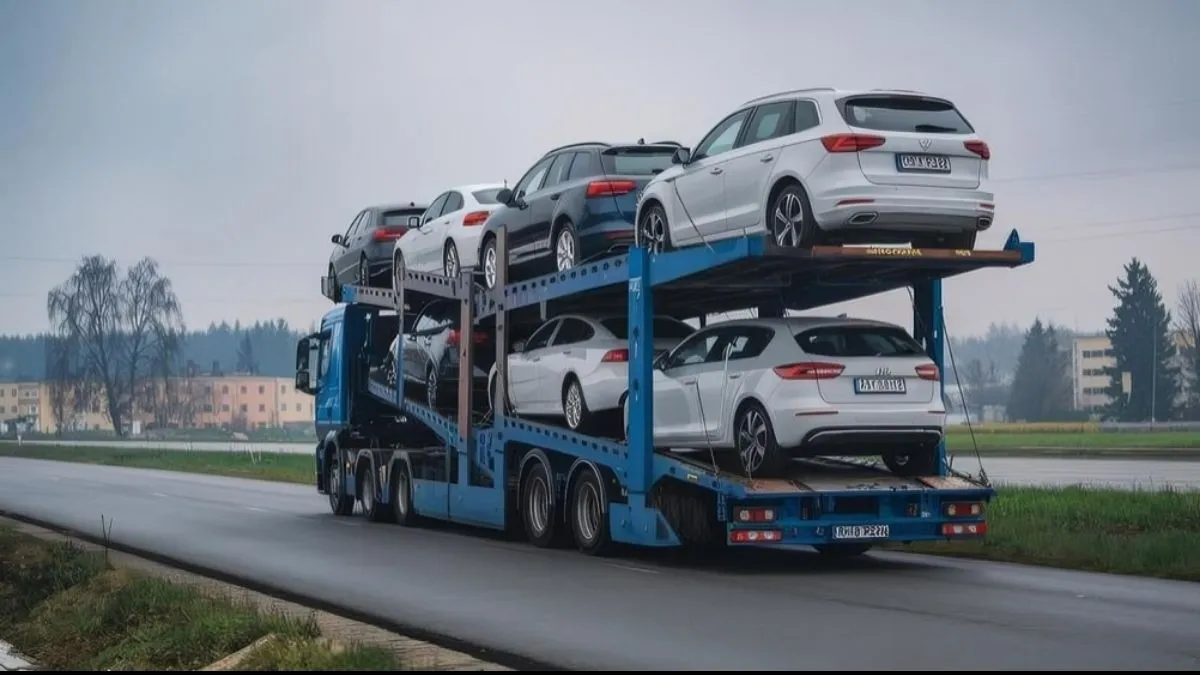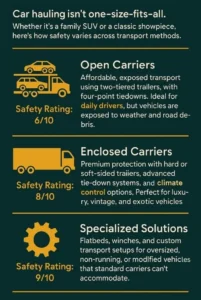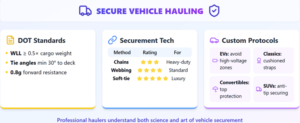SERVICES
How Safe Are Car Hauling Trailers For Your Automobiles?

This guide discusses the safety of using car shipping companies that employ car hauling trailers, such as open and enclosed carriers, to ship vehicles. We aim to educate car owners about how safe their vehicles will be during transit.
3 Car Hauling Options & Vehicle Safety They Offer:

1. Open Carriers
Open carriers are the most common sight on highways and typically hold 7–12 vehicles on two-tiered exposed trailers. Cars are driven up ramps, with the top deck lowering hydraulically during loading. Once positioned, each vehicle gets secured with heavy-duty straps to prevent movement during transit.
Safety Features:
- Four-point tiedown systems lock cars in place
- Weight distribution checks prevent shifting
- Regular inspections during transit stops
Safety Rating: 6/10
During transport, your car remains exposed to weather and road debris. Minor scratches can happen, but serious damage is rare, thanks to secure strapping methods. Open carriers work best for everyday vehicles and budget-conscious moves because they are 30-40% less expensive than enclosed ones.
2. Enclosed Carriers
Enclosed carriers provide premium protection, shielding vehicles from all external threats. Depending on the configuration, they can carry between 1 and 6 vehicles. Cars are loaded via hydraulic lifts or gentle-slope ramps, entering either hard-sided trailers with rigid walls or soft-sided versions with industrial-strength tarps.
Safety Features:
- Complete weather protection systems
- Advanced tie-down technology with soft straps
- Climate control options for sensitive vehicles
Safety Rating: 8/10
Your vehicle travels in a protected environment, safe from weather, debris, and prying eyes. Enclosed transport makes sense for luxury vehicles, classics, or anything you consider precious.
3. Specialized Carriers
When standard options won’t work, specialized hauling services step in. These custom solutions handle unique transport challenges that regular trailers can’t manage.
Each specialized carrier offers unique advantages. Flatbeds feature extra-low decks for easy loading of tall vehicles, and winch systems can gently pull non-running cars aboard.
Types & Capacity:
- Flatbed Trailers: Handle 1–2 oversized vehicles
- Winch Carriers: Perfect for non-running cars
- Single-Car Enclosed Haulers: Ultimate protection for one vehicle
These auto transport options provide solutions for vehicles with custom modifications or extremely low ground clearance that standard carriers simply can’t.
Safety Features:
- Reinforced frames for extra weight
- Hydraulic systems for gentle loading
- Custom tie-down points for unusual vehicles
Safety Rating: 9/10
These rigs offer tailored protection for specific needs. Your oversized truck or non-running project car gets exactly what it needs for a safe journey.
Secure Vehicle Hauling Services Go Beyond Simple Tie-Downs
The Department of Transportation doesn’t mess around regarding auto transport standards. Their rules have gotten much stricter over the years, now focusing on exact angles and tension requirements instead of just counting tie-downs. Companies that excel at long-distance car hauling know these rules inside out.
Specific Securement Requirements:
As per FMCSA Cargo Securement rules, carriers must follow:
- Tiedown Requirements: Articles 5 feet long or shorter weighing 1,100 pounds or less require one tie-down. Articles 5 feet long or shorter and weighing over 1,100 pounds require two tie-downs. Articles longer than 5 feet but shorter than 10 feet require two tie-downs, regardless of weight. An additional tie-down is needed for articles longer than 10 feet for every 10-foot increment or part thereof.
- Working Load Limit (WLL): The aggregate WLL of tiedowns used to secure cargo against movement must be at least one-half times the weight of the cargo.
- Tie Angles: Indirect tie-downs should be rigged at a minimum angle of 30 degrees to the deck.
- Performance Criteria: Cargo securement systems must withstand deceleration forces of 0.8 g forward, 0.5 g rearward, and 0.5 g laterally.
Modern Securement Technology and Methodology
When pros talk about four-point securement, they mean a strategic system that fights movement in all directions. It’s not just four random straps. This creates a 3D network that keeps your vehicle stable even on bumpy routes.
| Securing Method | Protection Level | Best For |
| Basic chain systems | Moderate | Heavy-duty vehicles |
| Webbing straps | High | Passenger vehicles |
| Soft-tie systems | Premium | Luxury/classic cars |
Today’s auto transport hauling uses specialized webbing that’s way better than old-school chains. These high-tech straps hold tight without transferring damaging vibrations to your car. The best vehicle hauling companies use backup systems, too—wheel chocks that kick in if the main straps ever loosen up.

Vehicle-Specific Protocols:
Different vehicles need different handling.
- Electric cars require carriers who understand battery pack positions and avoid securing near high-voltage components.
- Classic car transport demands extra cushioning around fragile parts and careful strap placement to protect irreplaceable bodywork.
- Convertibles need special attention for their soft tops and seals. Trucks and SUVs, with their higher centers of gravity, require strategic tie-down placement to prevent tipping during emergency maneuvers.
The best hauling services don’t use one-size-fits-all approaches.
What Can YOU Do? Preparing Your Vehicle for Safe Auto Transport Hauling:
1. Pre-Transport Vehicle Preparation
Check for fluid leaks and fix them promptly. Carriers reject leaking vehicles as safety hazards. Keep your gas tank at 1/4 full – just enough to load and unload.
Remove or secure loose accessories like roof racks and retractable antennas. Highway winds can damage unsecured items during auto transport hauling.
Disable car alarms or explain how to handle them. Ensure tires are properly inflated to prevent shifting during transit.
2. Documentation for Safety Verification
Take dated photos of your vehicle from all angles. Close-ups of existing damage protect both you and the hauling services provider.
| Documentation | Purpose |
| Photos | Prove a pre-existing condition |
| Mechanical issues list | Alert the driver to special handling needs |
| Inspection report | Official record signed by both parties |
Disclose mechanical problems that affect loading. Upon delivery, inspect thoroughly before signing off on the shipment’s bill of lading.
3. Working with Transport Companies
Research carriers’ safety records using the FMCSA website and their DOT number. Check for license status and any violations.
Inspect equipment when carriers arrive. Well-maintained trailers and proper tie-down systems indicate quality vehicle hauling.
Ask about the driver’s experience with your specific vehicle type. Verify insurance coverage and get written details about the claim process before shipping.
How Do Trucks Stay Stable During Long-Distance Car Hauling?
Weight distribution is crucial, with heavier vehicles positioned forward to maintain proper tongue weight (10-15%). Electronic stability control systems detect and correct unwanted movement. Physical features like dual-axle configurations and air suspension systems provide balanced weight distribution and adapt to changing road conditions.
Drivers employ specific techniques, including progressive acceleration/deceleration, regular tie-down tension checks, and reduced speeds on curves. This integrated approach creates redundant safety systems that keep vehicles secure despite varying terrain and weather challenges.
Should you wish to read more, visit our blog page. We’ve got more topics for you!
-

 BIOGRAPHY7 months ago
BIOGRAPHY7 months agoBehind the Scenes with Sandra Orlow: An Exclusive Interview
-

 HOME1 year ago
HOME1 year agoDiscovering Insights: A Deep Dive into the //vital-mag.net blog
-

 HOME1 year ago
HOME1 year agoSifangds in Action: Real-Life Applications and Success Stories
-

 BIOGRAPHY1 year ago
BIOGRAPHY1 year agoThe Woman Behind the Comedian: Meet Andrew Santino Wife




























